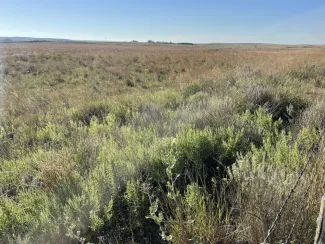Upland prairie habitat is something land managers and biologists speak about quite a bit because of the importance of these habitats for wildlife. Upland prairies, especially in the western half of Oklahoma, should contain a good mix of native grasses and flowering plants along with native shrubs and legumes. Deer, turkey, quail and a host of other species greatly benefit when prairie habitats are diverse.

Upland prairies that offer a diverse mix of native grasses, flowering plants, and shrubs can be wildlife hotspots for a mix of species.
As an example, upland prairie birds like Northern bobwhite require native warm-season bunch grasses for nesting, but a field of nothing but grass is far less beneficial. Having 30% shrub cover scattered throughout adds great appeal to wildlife. Brood cover is also important, usually providing ample bare ground among a mix of herbaceous plants comprised of 60% or more wildflowers and legumes. Even small grains and crops can serve as good brood cover if planted within or adjacent to good upland prairie habitat.
Like Northern bobwhites, prairie-chickens have similar requirements. In northwest Oklahoma where lesser prairie-chickens occur, a tight-soiled shortgrass patch or area at higher field elevations is critical for booming grounds or leks. Prairie-chickens also readily associate with shrubs like sand sagebrush for their nesting habitat. Unfortunately, lesser prairie-chicken hens will avoid nesting in areas with even a single eastern redcedar per acre, an issue that greatly impacts many acres across Oklahoma. Wild turkeys also use diverse, native hillside upland prairie areas for nesting, and nongame species like Bell’s vireo benefit too, especially where shrub cover like sand plum is available.
Native vs. Introduced Prairie Habitat
There can be some confusion between native grasses and grasses that have been introduced to the state. Native grasses would include big bluestem, Indiangrass, switchgrass, blue grama, sideoats grama, buffalo grass, and little bluestem. Species like old world bluestem and bermudagrass are not only non-native grasses, but they are also not wildlife friendly as they form dense mats where broods cannot move easily or forage. Old world bluestem also poses a greater challenge when wildfires emerge.
If upland prairie restoration is desired, combining a native seed mix of grasses and forbs is important for diversity, but using fewer seeds of little bluestem and switchgrass, especially in Eastern Oklahoma, is recommended as these species can dominate a site over time. Examples of beneficial native forbs include common ragweed, croton, showy partridge pea, Illinois bundle flower, sunflowers, milkweeds, prairie clovers, coneflowers, goldenrods, and pigweeds. Beneficial native shrubs include sand sagebrush, sand plum, fragrant sumac, smooth sumac, winged sumac, and shinnery oak.
It is important to pay attention to and treat existing and future eastern redcedar issues as these trees can quickly overtake a prairie while also lowering the water content in the soil, sometimes up to 21 gallons per day. Eastern redcedars also serve as ladder fuels with volatile oils that can create a dangerous situation for those fighting wildfires. Remember, you do not need cedars to have big white-tailed deer and removing the cedar cover will greatly enhance the grass and forb response for cover and food respectively. Prescribed burning after you remove the cedars will help control any remaining cedar seeds that germinate and serve to manage upland prairie habitats for the benefit of suite of game and nongame species alike.